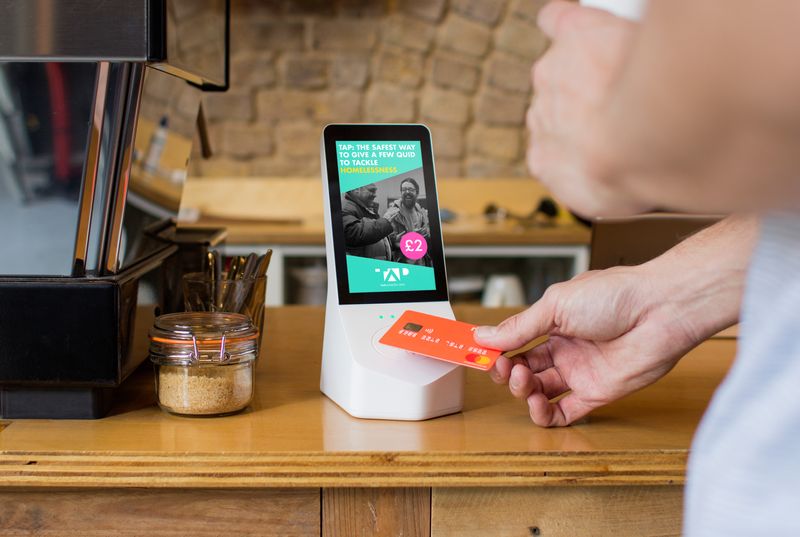Getting started with cashless giving: what to consider before diving in

With many retailers currently choosing to accept only contactless payments, and rising transaction limits making this payment method ever more convenient, post-pandemic few of us expect to return to carrying coins and notes in the same way as before.
For charities, it means many more are now looking at cashless giving methods to keep donations coming in, from contactless and online donations, to text giving, QR codes, and NFC tags.
The good news is people were already embracing these methods as a way of supporting good causes pre-pandemic, and the past year has only seen this increase.
Advertisement
Samantha Lade, Senior Project Manager at Donr says:
“People aren’t carrying cash, but everyone carries a mobile phone or contactless card. Wherever they are, your supporters have a donation tool right there in their pocket.”
The National Funding Scheme’s DONATE™ platform, for example which integrates text, web and contactless giving, saw donation revenue soar to £1.2 million last year, up from around £215,000 pounds in 2019.
William Makower, its Founder-Trustee says:
“We’re finding text by far the most popular giving option at about 80% of all donations by volume. We had four and a half times as many donations in 2020 by text as we did in 2019. There has also been a very large increase in web donations where the pound amount is much, much higher.”
Developments in technology are further increasing the advantages of digital payment technology for charities, as Elliot Green, Communications Director at Wonderful explains:
“One exciting development, open banking, is changing what’s possible when it comes to cashless donations. Cashless donation solutions are now starting to allow charities to receive instant, direct payments authorised by the donor’s existing mobile banking app. The whole process can be initiated on the move, by tapping or scanning with a mobile device. These ‘Pay by Bank’ solutions help improve donor confidence, as well as offering significant cost savings for charities when it comes to transaction fees.”
For the best chances of success however, there are a few key points to consider before diving in.
Address the practicalities
For one, the practicalities of getting up and running, from finance to solution requirements, require very careful thought.
Joe Geary, Marketing Manager at GoodBox advises:
“Define the budget you’re comfortable investing and ensure you can meet any requirements like having a reliable internet connection, especially if the device doesn’t accept offline donations. Consider your overall strategy and decide which digital fundraising method would complement it best.”

TAP London: one of a number of contactless giving points rolled out across the capital with GoodBox
Contactless terminals for example come in all shapes and sizes, from handheld readers to tabletop and freestanding devices, and can even be integrated into a wall or a window. They generally let charities include branding and messaging and set a variety of donation amounts and many still collect donations when offline.
Tap London for example has placed 100 contactless giving points around the capital, and has received over 58,000 taps since launch, each one a £3 donation, with the technology for the contactless donation points provided by its partner GoodBox.
With many venues and events closed over the past year, many charities have turned to text giving.
Donr’s Lade says:
“A text call to action is just as simple to implement during a virtual event as it is in a physical venue – so whatever the new normal may be, text giving is a flexible option allowing you to fundraise in both the online and offline worlds.”
Working with Donr, last year Keech Hospice Care used text giving during a series of quizzes streamed online, while National Theatre and Barn Theatre have used text giving to ask for donations during broadcasts of performances. In fact, Donr saw a 653% year-on-year increase in funds raised between March and July through its text giving platform last year.
QR codes are also growing in popularity. Answering the requirement for a tillpoint solution, a partnership between Band of Builders and Jewson will see QR codes, created by Supported Giving, displayed in outlets with the opportunity to donate a variety of fixed amounts, or to choose their own up to £100. Mourne Mountain Rescue, which needed an unattended, all-weather, low maintenance solution to engage walkers and climbers, is also using them. Displayed in the mountain’s car parks, there is one QR code for donations, and a second providing useful mountain safety tips.
Adam Maxted, Supported Giving’s CEO says:
“We’re seeing more and more uptake of QR codes – having to use them to check into establishments for Test & Trace has really helped accelerate awareness, and shown how easy they are to use. Charities are also finding that with set up from as little as £250 and it possible for each one to be unique and independently tracked, they’re cost-effective, easy to configure, as well as highly measurable.”

Mourne Mountain Rescue’s QR codes: one for donations, and one for mountain safety tips
Consider the audience giving point
The examples above also show the importance of taking into account the audience giving point when deciding what cashless fundraising method to use, and this too is critical.
Makower explains:
“QR codes, mobile, web, and contactless can all be great but the giving psychology with each is utterly different. With web for example, you’re reading, and seeing images, so you’re going to get more engaged as to why you’re giving to that specific charity, while with text it’s much quicker, it’s transactional. So text works really well where there’s a short time period to make a donation: it’s good in a stadium type environment, if you’re multi screening, and if you’re watching something on TV, but if you want people to engage with the idea of becoming long-term donors it’s probably better to use web.”
Make sure you get staff buy-in
You may have a great device or solution lined up but you also need to get the buy in of the people who will be directly using them and interacting with donors.
Geary says:
“It’s vital that all team members are bought into the new strategy, are comfortable using the technology and can answer any questions your donors may have. If your staff aren’t comfortable using them, contactless devices might be left gathering dust on a shelf rather than helping you achieve your mission. Staff training sessions, information packs and regular check-ins at the early stages can go a long way to ensuring your team have everything they need to make your campaign a success.”
Test & learn
The only way to really know if something works of course, once you’ve got your strategy and your technology in place, is to test it. Consider the location of devices and any messaging. Do you get better results when they’re placed at the entrance or exit of a location for example? Is the ‘ask’ prominent enough? Is the default donation amount too low or too high? Do devices perform better in a manned or unmanned environment? Be ready to alter your strategy if necessary.
Charities can also utilise their existing donor communications to test cashless fundraising methods, adding the likes of QR codes and text to donate options to activity on other channels to see what response they bring in.
Maxted says:
“If you’re doing direct mail, why not add a QR code to appeal to younger donors? For TV advertising, why rely just on someone making a call to a live call centre or visiting the charity URL to donate – viewers will have their mobile near to them so include text to donate as an added option. All of these things are trackable so you can see precisely how many donations they’re bringing in, and where they’ve come from.
Next steps
Of course, this is just the start, and there is plenty more to consider and get right to make cashless fundraising appeals a success. Check out this selection of links for more help and ideas:
A round up of round up (& micro-donation) solutions 10 March 2021
Four key ways to use SMS in your fundraising programme 10 March 2021
12 contactless ways charities can fundraise this Christmas 15 December 2020
Cash & coronavirus: the implications for charities 1 June 2020
Thyngs & Charities Trust create free solution to help brands fundraise for charities 3 April 2020
Cost effectiveness of contactless giving examined in white paper 3 July 2019



